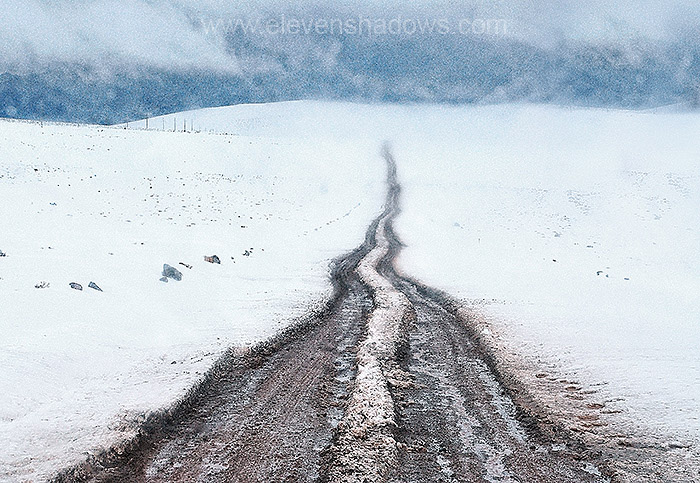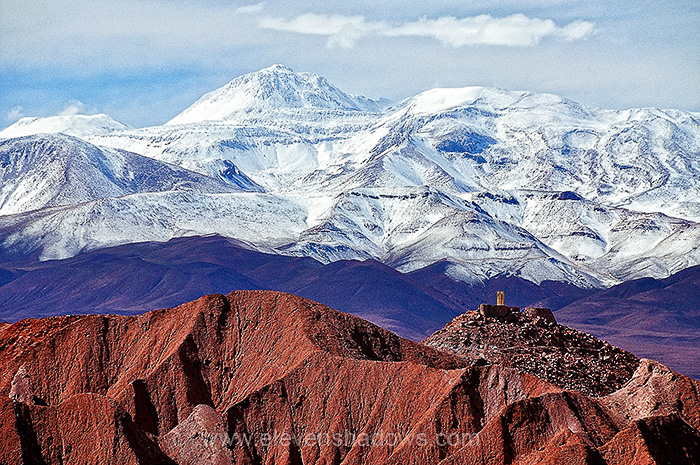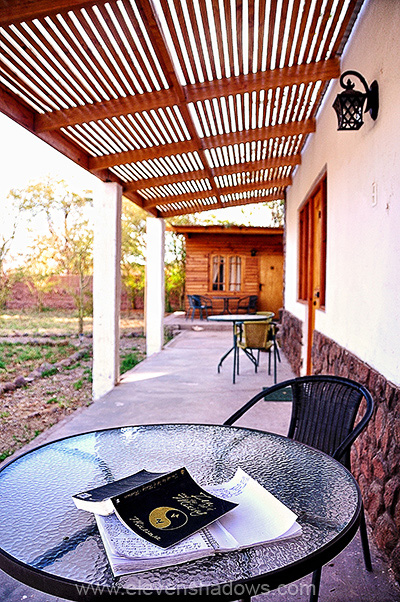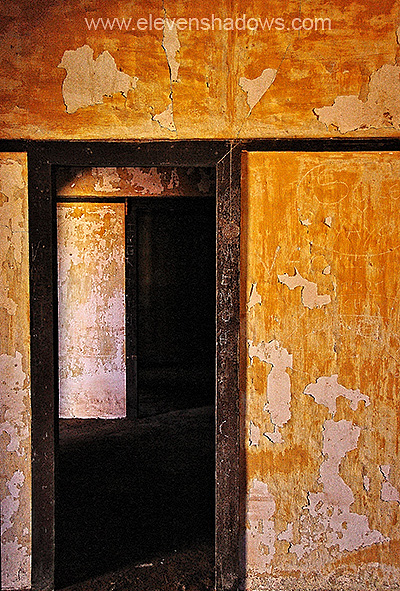
Chile, Atacama Desert, June-July 2011: Valle de la Luna, Snowbound in Ollague, Bike Ride to Valle de la Muerte, The Abandoned Ghost Town of Humberstone
Page 5 of 7
![]()
And it was also my country's birthday. Although the Bolivia trip was strange and very disappointing, I thought that watching a magnificent sunset in Valle de la Luna was a good way to spend the Fourth of July. |
This is the road as we approached Ollague. |
A strange man with long stringy hair came on board, talking with a husky gravelly voice. He claimed that the volcano in the distance was the shortest volcano. However, I had been to Valle de la Volcanes in Peru. They had volcanoes that were only 2 or 3 meters in height. He wanted us to take him back to San Pedro. The bus driver said no, finally sending him off. We waited. We ate. We waited. |
 After two hours, we drove up the road again. More snow. Trucks were stuck. We had to turn back before getting hemmed in. I was disappointed, feeling my chances for going to Salar de Uyuni quickly evaporating. After all, the amazing reflective salt flats of Salar de Uyuni were much of the reason I had come on this trip. After two hours, we drove up the road again. More snow. Trucks were stuck. We had to turn back before getting hemmed in. I was disappointed, feeling my chances for going to Salar de Uyuni quickly evaporating. After all, the amazing reflective salt flats of Salar de Uyuni were much of the reason I had come on this trip. |
Someone requested going to the bathroom. Turns out some of the females had been uncomfortable peeing in wide open country where the bus had been stopped for several hours. We stopped in a little village called Chiu-Chiu, not far from Calama. I was able to photograph the Iglesia de San Francisco, a national monument, and built in 1540, thought to be Chile's oldest church. |
A few days later, an Australian tourist named Natalie, a Dutch tourist named Frek and I were sharing sunset photos of this amazing day. When I showed this to Frek, he said, "I think you got lucky." I showed him the next one, which was just as beautiful. Then another one. He shook his head. If you're right, Frek, I get lucky a lot.
|
While trying to figure out where I could go and how to do it at the bus company, I had seen a restaurant advertising beef stroganoff, one of my favorite dishes, and Chilean wine. After my frustrating day of dead-ends, this sounded like a positive thing to do. And to add to it, I ended up eating with three Australian women who I had met earlier in the day dudring their similar attempts to flee. Two were teachers. They just simply had quit work to travel. Nice. The wine was delicious. The beef stroganoff, not so much. It didn't resemble the dish and curiously came with potatoes, but no noodles. But no matter, a good evening. ~~~ 7 julio, jueves: After more attempts to go to Valparaiso, I rented a bike. This time, no intense wind, just a beautiful day. Perfect. The ride to Valle de la Muerte is an easy incline for only about 4-5km, a pleasant ride, riding up the dirt road of the Cordillera de Sal that leads to the valley. This felt great. I rode everywhere up the canyon of salt, walking around, sitting, eating, drinking, walking, riding. |
 A view from Valle de la Muerte, looking toward the snow-capped Andes peaks and Bolivia beyond. A view from Valle de la Muerte, looking toward the snow-capped Andes peaks and Bolivia beyond. |
 Taking a moment for a self-portrait and to eat some delicious Doña Bertita empanadas between climbing sand dunes in Valle de la Muerte. Taking a moment for a self-portrait and to eat some delicious Doña Bertita empanadas between climbing sand dunes in Valle de la Muerte. |
I hiked some more, then rode my bike back down the bumpy dirt and sand road through the Cordillera de Sal, taking a left, leading up and over an incline, popping out on Callejon Flores and onto Quitor Road, not far from the fortress at Quitor.
|
 Back in San Pedro, I stopped at Estrella Del Sur, who earlier suggested to stop by for further updates on going to Salar de Uyuni tomorrow (Friday). But now they said the road was impassable for tomorrow. I had already decided that I would ride a bus to Iquique, along the coast, some 7 hours away. This confirmed that. I rehydrated from the bike ride and read "Zen And the Art of Mixing"by Mixerman at Hostal Terracota before going to dinner at Inti Sol. And then I purchased my bus ticket to Iquique for the next day. Back in San Pedro, I stopped at Estrella Del Sur, who earlier suggested to stop by for further updates on going to Salar de Uyuni tomorrow (Friday). But now they said the road was impassable for tomorrow. I had already decided that I would ride a bus to Iquique, along the coast, some 7 hours away. This confirmed that. I rehydrated from the bike ride and read "Zen And the Art of Mixing"by Mixerman at Hostal Terracota before going to dinner at Inti Sol. And then I purchased my bus ticket to Iquique for the next day. |
~~~ 9 julio, sábado: I caught a colectivo from the central market of Iquique to Humberstone. Humberstone is an abandoned ghost town, a former nitrate town located 46km east of the coastal town of Iquique, higher up in the Atacama desert. It was founded by James Humberstone of the Peru Nitrate Company in 1872 (back then this region was in Peru), calling the location La Palma, renamed in 1934 to Humberstone. From pre-Hispanic times indigenous peoples in the area, the Atacamenos and the Incas, used nitrate as a fertiliser, extracting and grinding the saltpeter and spreading it on fields. Later, the Europeans showed interest in the saltpeter, using it for explosives, and after that, for fertilizer. But Humberstone didn't just build a mine. It was a whole town, complete with a theater where international celebrities of the day performed. And it had schools, a plaza, a hotel, a ballroom, tennis and basketball courts, and more, as well as the extraction and refineries for nitrates. And there was this swimming pool, with its diving boards still intact. This swimming pool was entirely made from cast iron scavenged from a shipwreck. |
 Some of the living quarters for pampinos, those working in the nitrate mining towns, who had families. While some of the buildings have been restored, still others have been left to decay. Some of the living quarters for pampinos, those working in the nitrate mining towns, who had families. While some of the buildings have been restored, still others have been left to decay. |
|
|
In 1879 the Saltpeter War involving Chile, Bolivia and Peru (who supported Bolivia) gave Chile dominance of the industry. This further encouraged European investment, and Chile prospered. In just a few short years, saltpeter accounted for half of Chile's total revenue. However, World War I was disastrous in general for saltpeter producers. The sea routes were unsafe for delivering nitrates. But still, what really kicked places like Humberstone to the curb were the development of synthetic nitrates, forcing the closure of Humberstone by 1960, which was consequently abandoned. But unlike Chacabuco, Humberstone was never used as a concentration camp during Pinochet's regime. To this day, Chacabuco remains surrounded by landmines. There are also landmines on the way to Valle de Arcoires, near the border of Bolivia and Argentina, most of which are marked, and most of which have been already found. Still, every year, a handful of Chileans lose a limb, and one of the guides said that one can occasionally see three-legged vicuñas. The landmines have killed dozens of people, most of them traffickers smuggling drugs into Chile from the north. Chilean Foreign Ministry official Luis Winter lost both legs during an inspection of de-mining work near the Peruvian border in 2005. These landmines were planted by Pinochet during an "almost war" that was narrowly averted by last minute intervention by John Paul II in the 1970s, mediating between Chile, Peru, Bolivia, and Argentina. Chile has vowed to remove the remaining landmines by 2016. |
|
Ken's photos of Nobel Peace Prize Winner Aung
San Suu Kyi, as well as photos of Peru, Burma, India, Morocco, China, Thailand,
Ghana, Ecuador, and elsewhere, have appeared in many books, magazines,
websites, and galleries. Visit the
Ken Lee Photography Website. Some of Ken's select photos may be
purchased through his
Imagekind Store. |
Chile, Atacama Desert, June-July 2011
Page 5 of 7
Eleven Shadows Travel Page
Contact photographer/musician Ken Lee